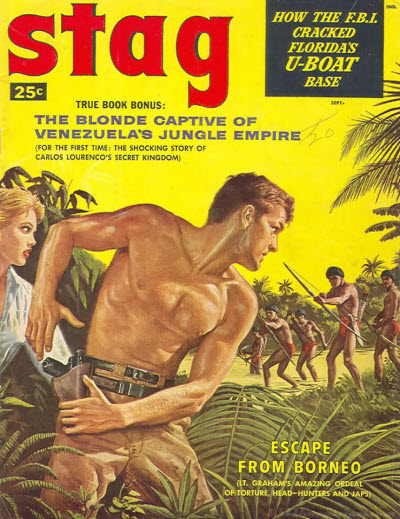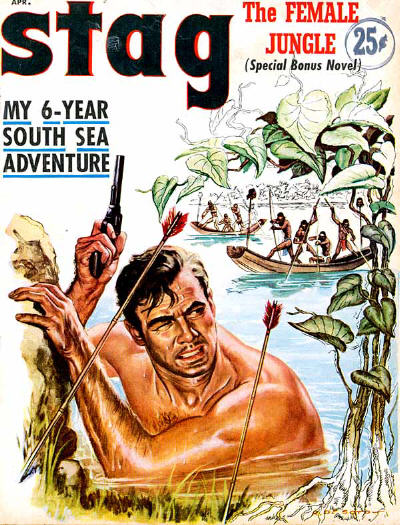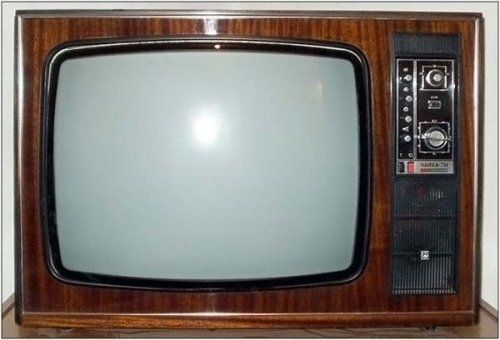 |
Here are the answers to yesterday's TV trivia questions.  PERRY MASON PERRY MASON, starring Raymond Burr, ran on CBS from 1957 to 1966 and used the word "case" in the title of every episode, in keeping with the titles of the original novels by Erle Stanley Gardner (many of which were adapted for television).  RAWHIDE RAWHIDE, starring Eric Fleming (above, left) and Clint Eastwood (above, right) ran on CBS from 1959 to 1966 and used the word "incident" in the title of every episode. I've recently watched INCIDENT OF THE DAY OF THE DEAD and INCIDENT OF THE SHAMBLING MAN.  THE MAN FROM U.N.C.L.E. THE MAN FROM U.N.C.L.E aired on NBC from 1964 to 1968. The series starred Robert Vaughn and David McCallum and used the word "affair" in the title of every episode.  THE WILD, WILD WEST Ross Martin (above, left) and Robert Conrad (above, right) starred in THE WILD, WILD WEST which ran on CBS from 1965 to 1970 and used the word "night" in every episode title. |
Friday, May 31, 2013
TV TRIVIA TIME ANSWERS
HAPPY BIRTHDAY!
 |
Clint Eastwood, my all-time favorite movie star, turns 83 today. Thanks for all of the great memories and best wishes for many, many more happy birthdays to come. |
Thursday, May 30, 2013
THE STREETS OF SAN FRANCISCO
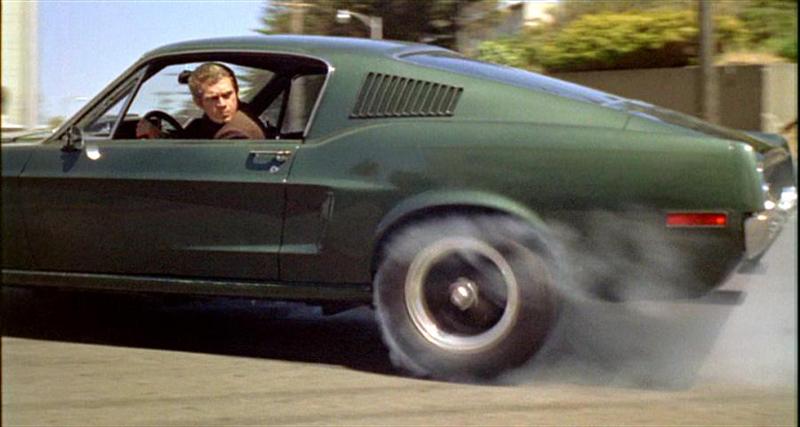 |
BULLITT, starring the uber-cool Steve McQueen, plays tomorrow night (Friday) at the Stateside Theatre (next to the Parmount) at 7:15 p.m. Here are my film notes for this neo-noir classic that features the greatest car chase sequence ever filmed.
Crime films and detective
dramas have always contained an element of action and the hard-boiled school of
American crime films is rife with physical conflict and assorted forms of
mayhem: gun battles, stabbings, strangulations, explosions and the good
old-fashioned knockdown, drag-out fist fight. Criminals in these films are a
vicious, bloodthirsty lot, and it takes a hero who is equally tough to stand up
against the forces of evil, delivering justice with two fists and blazing guns.
The archetypes were
established early. John Huston’s 1941 classic The Maltese Falcon, faithfully adapted Dashiell Hammett’s pulp
novel and made Humphrey Bogart, as private detective Sam Spade, an icon. Bogart
further defined the tough guy private eye in Howard Hawks’ The Big Sleep (1946), again drawing on a literary source, Raymond
Chandler’s often imitated but seldom equaled Philip Marlowe novels.
There are countless other
examples, and the crime /detective genre has remained steady since the 1930s,
while other types of films have come and gone and come back again. The tough
detective, either as an agent of an established police force or as a lone
private operative, has always been a popular film fixture.
Peter Yates’s Bullitt brought several new elements to
the genre. First and foremost was the star, Steve McQueen. McQueen, who died in
1980, was a major film icon of the ‘60s and ‘70s. He personified the detached,
rebel/loner figure, the so-called “anti-hero” that was gaining prominence in
the popular culture of the day. To an entire generation of moviegoers, McQueen
was the living, breathing avatar of cool with a capital “C”.
McQueen parlayed a starring
role in the television western series Wanted:
Dead or Alive into a film career that
included such classics as The Magnificent
Seven (1960), The Great Escape
(1963), The Cincinnati Kid (1965) and
The Sand Pebbles (1966). McQueen was
at the height of his popularity when he made Bullitt and he stars in the title role as the burned-out detective
Lieutenant Frank Bullitt, a man who is good at his job, but who has doubts
about why he continues to do it.
In the course of the film,
Bullitt is called upon to protect a key witness in an upcoming trial of a mob
boss. When the witness is gunned down under suspicious circumstances, Bullitt
begins to investigate and finds a path of corruption leading straight to city
hall. The supporting cast is excellent and there are many familiar faces here,
almost a “who’s-who” of 1960s detective films and television shows: Simon
Oakland, Robert Duvall, Don Gordon, Vic Tayback, Norman Fell, and the supremely
unctuous Robert Vaughn, fresh from his stint as Napoleon Solo, television’s Man from U.N.C.L.E. (a James Bond
inspired spy series, for those of you under 50).
Director Peter Yates makes
great use of the San Francisco locale, giving the film a gritty, realistic
feel, and it’s those famed streets and hills that give Bullitt its most memorable element: the greatest car chase sequence
ever filmed. Cameras were placed inside two cars (a Mustang Cobra with McQueen
behind the wheel in many shots, and a Dodge Charger), to capture the giddy,
feel-it-in-the-pit-of-your-stomach thrills as the cars hurtle down the steep
hills. It’s one of the great cinematic set pieces of all time, brilliantly
staged and edited by Frank Keller. Bullitt
received two Academy Award nominations: Best Sound and Best Film Editing
(winner) and ranks number thirty-six on the American Film Institute’s list of
one hundred greatest thrillers of all time.
Following the success of Bullitt, McQueen made such other stand
out films as The Thomas Crown Affair
(1968), The Getaway (1972) and Papillon (1973). His last film was The Hunter (1980).
SOMETIMES NOTHING...
 |
COOL HAND LUKE plays tomorrow (Friday) night at the Stateside Theatre (next door to the Paramount) at 9:30 p.m. Here are my film notes for one of my all-time favorite movies.
The late Paul Newman, in
addition to being one of the greatest American film actors of the last fifty
years, was also a true renaissance man. In addition to acting, Newman was a
director, entrepreneur, humanitarian and auto racing enthusiast. Was there
nothing this extraordinarily gifted man could not do? But it was on the big
screen that Newman captured our hearts. Impossibly handsome, Paul Newman could
have been just another pretty face. But in addition to that grin and those
incredible blue eyes, Newman had the acting chops to play both comedy and drama
and excel at both. Ladies loved him. Men wanted to hang out with him and we all
wanted to see what unforgettable character he would bring to life in each
film.
Newman, like so many other
actors of his generation, had his first exposure to working in front of a
camera in the live television programs of the 1950s. He made his Broadway debut
in Picnic in 1953. Hollywood soon
called and his first film, The Silver
Chalice (1954), was almost his last as Newman felt his performance was so
bad that he took out an ad in the trade papers to apologize for it. He fared
much better with his next effort, Somebody
Up There Likes Me (1956), in
which he played boxer Rocky Graziano. Newman’s performance this time drew rave
reviews, and his career was off and running.
Paul Newman was one of the
few actors to successfully make the transition from the cinema of the 1950s to
the new breed of films that came about in the 1960s. His rebellious persona
translated extremely well to audiences of the sixties. Beginning with Cat on a Hot Tin Roof in 1958 (in which
he co-starred with the supra-luminal Elizabeth Taylor), Newman made a series of
films that enjoyed both box-office and critical acclaim including: Exodus (1960), The Hustler (1961), Hud
(1963), Harper (1966), Torn Curtain (1967), Hombre (1967) and Cool Hand Luke (1967). He teamed with Robert Redford twice for the
enormously popular Butch Cassidy and the
Sundance Kid (1969) and The Sting (1973).
In the course of his career,
Newman appeared in more than fifty films, worked in several highly acclaimed
television productions and lent his voice to the delightful animated feature Cars (2006). He received eight Best
Actor and one Best Supporting Actor Academy Award nominations for Cat on a Hot Tin Roof (1958), The
Hustler (1961), Hud (1963), Cool Hand Luke (1967), Absence of Malice (1981), The Verdict (1982), The Color of Money (1986), Nobody’s
Fool (1994) and Road to Perdition
(2002). Newman’s only Oscar came for his work in The Color of Money. But it
was in the sixties that Newman did some of his best, career defining work as
the film on display here so unforgettably demonstrates.
“What we have here is failure to communicate.”
That memorable line of
dialogue became the tagline used to promote Cool
Hand Luke, a leading candidate for the title of “sweatiest movie ever made”
(the other nominees include Ben-Hur
and Body Heat). Luke (Newman) is a
rebellious prisoner on a Southern chain gang who refuses to have his spirit
(and his sense of humor) broken. His standing among his fellow prisoners
achieves mythic status for his card playing ability, his knockdown, drag out
fight with fellow prisoner Dragline (Kennedy), his consumption of 50
hard-boiled eggs in one hour and his repeated escape attempts.
As in his other “H” films (The Hustler, Hud, Harper and Hombre) Newman defines the anti-hero, a
man outside of the system living life on his own terms. As Luke, he’s at his
devil-may-care, laid-back best as he butts heads with the brutal prison camp
overseers, memorably played by the immortal Strother Martin (who delivers the
line quoted above) and Morgan Woodward as the sinister boss, “the man with no
eyes.”
Cool Hand Luke
is studded with a veritable who’s who of character actors, many of whom went on
to become stars in their own right, either in films or on television. You’ll
spot many familiar faces including Dennis Hopper, Harry Dean Stanton, Joe Don
Baker and Wayne Rogers, among others. The film is full of raucous humor, great
dialogue, terrific performances and memorable scenes. It’s one of Paul Newman’s
best films and one of the great American films of the 1960s. Cool Hand Luke received four Academy
Award nominations including: Best Actor (Newman), Best Supporting Actor
(Kennedy, winner), Best Adapted Screenplay and Best Original Music Score.
THE CASE OF THE INCIDENT OF THE NIGHT OF THE AFFAIR
 |
Hey kids, it's TV trivia time! Four long running, classic television shows each had a very distinctive way of titling their episodes. Can you name the shows that used the following words in the title of each episode of the respective series: 1. CASE 2. INCIDENT 3. AFFAIR 4. NIGHT Answers tomorrow. Stay tuned. |
IT TAKES A PAT...
 |
| IT TAKES A PAT...
I watched an episode of THE RIFLEMAN last night. The lovely Patricia Blair, pictured above, was one of the guest stars. It struck me that she would have made a very nice Patricia Savage in that imaginary Doc Savage movie starring Chuck Connors that I seem to be obsessed with. What do you think?
The RIFLEMAN episode was interesting due to the fact that in addition to Ms. Blair, the other guest star was Ed Ames (playing a bad guy). Blair and Ames would later co-star on the long running DANIEL BOONE television series starring UT alum Fess Parker. The hour-long, color adventure series ran on NBC for several years and I always enjoyed watching it when I was a kid. Blair starred as Rebecca Boone, Daniel's wife, while Ames was Boone's native American friend, Mingo. Of course, Ames's greatest claim to fame came when he appeared on THE TONIGHT SHOW starring Johnny Carson. Ames demonstrated the art of tomahawk throwing, a segment that ended in a very memorable way and became a standard clip on every TONIGHT SHOW anniversary show for many years after. Here's how it ended up.
 |
MY MEN'S ADVENTURE MAGAZINES 19
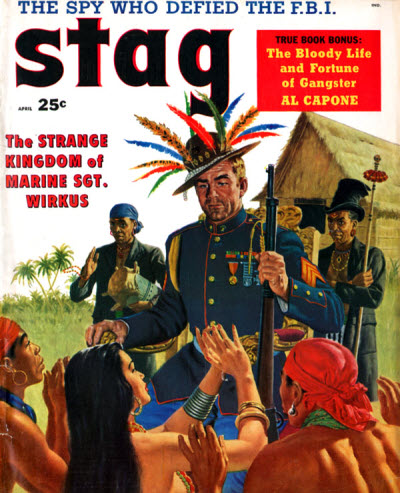 |
STAG for April, 1958, has all of the classic adventure tropes featured on the cover: a marine sergeant's private kingdom in some exotic land, Al Capone, spies and the F.B.I. Great stuff! Purchased on eBay several years ago. |
Wednesday, May 29, 2013
THE SAVAGE CINEMA OF THE 1960s
 |
You can catch a double feature of BONNIE AND CLYDE and THE WILD BUNCH at the Stateside Theatre (next door to the Paramount) tonight. In case you can't make it, here are my film notes.
|
In the late 1960s, there was
revolution in the air. Everywhere you looked, something new, radical and
groundbreaking was taking place. Protests against the war in Vietnam were reaching
fever peak while popular music, clothing fashions, hairstyles, books,
television, art, comics and more morphed right before our eyes as new ideas,
concepts and styles came into vogue. It was out with the old and in with the
new on a grand scale.
Change was also taking place
on the screens of movie theaters across the country. A good case can be made
that was the tipping point in cinema history when “movies” became “films”. The
great golden age of cinematic experimentation that flowered in the 1970s with
the debuts of such influential filmmakers as Martin Scorsese, George Lucas,
Steven Spielberg, Francis Ford Coppola and others, grew from the seeds that
were planted in the late ‘60s. For starters, the studio system, long the
standard model for film production and distribution, was for all intents and
purposes, dead. The major studios that remained in business in the late 1960s
were using their studios and sound stages to produce more and more television
shows in addition to motion pictures and some studios served more as simply
distributors for films that had been produced by outside, independent parties.
In addition to the way films
were made and distributed, the content and subject matter of movies were
undergoing a sea change. More and more adult themes were being openly explored.
Sex in the cinema was no longer strictly taboo, although major changes in the
way sexuality was displayed in films were still a few years off. But the
depiction of cinematic violence was about to be blown away by the explicit and
extreme bloodletting depicted in the two films on display here. Up to this
point in film history, gory movie violence was relegated strictly to grind
house and drive-in exploitation films. These two landmark works changed that
paradigm forever.
The story of legendary
depression era outlaws Bonnie Parker and Clyde Barrow had been used as
cinematic fodder several times over the years. Fritz Lang’s You Only Live Once (1937) has parallels
to the duos’ story and the more in-your-face The Bonnie Parker Story (1958), was a cheap exploitation film. The
best use of the Bonnie and Clyde material in a film prior to 1967 remains director
Joseph Lewis’s Gun Crazy (1949), a
classic film noir that featured two doomed lovers on the run and dazzlingly
camerawork.
Bonnie and Clyde was a point blank blast from both barrels of a sawed-off shotgun.
Warren Beatty (who also produced the film) stars as the sexually impotent
Clyde, while Faye Dunaway makes an appealing Bonnie. The real-life couple was
nowhere near this sexy and glamorous and although Beatty and Dunaway give good
performances, it’s hard to ever buy into them completely as Depression era
desperadoes. They’re just too pretty, too much “movie star” to really bring the
characters to life. Secondary actors Gene Hackman, as Clyde’s brother Buck and
Estelle Parsons as Buck’s wife, Blanche, bring more believability to their
roles.
The film plays fast and loose
with the historical facts: Michael J. Pollard’s character is a composite of
several of Bonnie and Clyde’s running buddies, Beatty and Dunaway meet as
adults at the beginning of the film when in reality the couple knew each other
for years before turning to crime, it’s unclear what a Texas Ranger (Pyle) is
doing in Missouri in the film but the real-life Frank Hamer never met Bonnie
and Clyde until he helped gun them down, and the duo’s career is compressed
with several major crimes and murders omitted.
But what Bonnie and Clyde gets right is the period detail. The cars, the clothes,
the look of small-town Depression era America is perfectly captured. One of the
most controversial elements of the film was its’ whipsawing between light and
dark. Moments of shocking violence (with one brief shot echoing Eisenstein’s Potemkin (1925)) are followed by scenes
of light comedy and the action is punctuated by a bluegrass score that is
authentic to the era. One standout scene is the visit to the Parker family. The
sequence, shot in a soft-focus style, is a poetic harbinger of the grim fate that
awaits Bonnie and Clyde and lets us know that their lives will not end well.
And when that end comes, it is shown in what was at the time, some of the most
explicit cinematic violence ever filmed.
Bonnie and Clyde received ten Academy Award nominations including: Best Picture, Best
Director, Best Actor (Beatty), Best Actress (Dunaway), Best Supporting Actor
(Hackman), Best Supporting Actor (Pollard), Best Supporting Actress (Parsons,
winner), Best Original Screenplay and Best Cinematography (winner). Bonnie and Clyde ranks number forty-two
on the American Film Institute’s list of the best one-hundred films of the last
one-hundred years.
Sam Peckinpah’s The Wild Bunch is a blood-soaked elegy
for both the end of an historical era and the end of the traditional movie
western. The outlaw gang known as “the wild bunch” are men who are past their prime,
19th century desperadoes on a collision course with the world of the
early 20th century who find that there’s no place left in society
for over-the-hill bandits and killers. As in many other westerns (and crime
films), the gang decides to pull one last job and retire. Fate plays them a
different hand.
William Holden is the leader
of the gang which is comprised primarily of Warren Oates, Ben Johnson and Ernest
Borgnine. Robert Ryan is a former member of the gang who has turned bounty
hunter and is stalking the bunch for the reward money. The bunch execute a
spectacularly staged bank robbery in the film’s opening sequence and cross the
border into Mexico where they run afoul of Mapache, a double-crossing Mexican
warlord. Caught between the murderous Mapache and the rapacious bounty hunters,
the bunch has nowhere left to run. When Angel, a young member of the gang, is
taken prisoner by Mapache, the bunch decide to follow their rough code of honor
and loyalty and free their friend while killing as many Mexican soldiers as
possible.
The climactic sequence of the
film, the legendary “Battle of Bloody Porch” is one of the greatest set-pieces
in film history. Brilliantly and brutally staged, Peckinpah, director of
photography Lucien Ballard and editor Lou Lombardo combine their talents and
expertise to deliver a gun battle that is pitched on an operatic scale. It was
shocking at the time and it still packs a visceral punch but it’s a fitting end
for the bunch.
The Wild Bunch
received two Academy Award nominations: Best Original Screenplay and Best
Original Score. It ranks number seventy-nine on the American Film Institute’s
list of one hundred best films of the last one hundred years.
WARNER BROTHERS DOUBLE FEATURE
_05.jpg) |
Tonight's the last night to catch the ANGELS WITH DIRTY FACES/I AM A FUGITIVE FROM A CHAIN GANG double feature at the Paramount Theatre. In case you can't make it, here are my film notes.
|
American movie goers in the
1930s needed escape more than ever before. The country was in the midst of the
Great Depression and audiences flocked to films that allowed them to take their
minds of their daily troubles for a few hours and live in a fantasy world of
perfectly realized escapist fare. Musicals were popular, as were comedies of
all stripes. Westerns, historical dramas, even horror films, offered something
different, a much needed distraction from reality.
One major Hollywood studio
built its’ reputation by producing films that were more realistic and more
reflective of life (especially urban life) in America. Warner Brothers, through
a series of gangster, crime and social melodramas, held contemporary America up
to a magnifying lens and gave audiences an unvarnished look at the ills plaguing
society at the time.
But make no mistake about it.
As socially relevant as these gritty, tough films were, they weren’t
documentaries or entirely full of political rhetoric and the polemics of
propaganda. These films were, first and foremost, entertainments. They had to
tell a compelling story, using engaging characters who struggle to overcome
their problems. By the final reel, some semblance of justice always prevailed.
The evil met their fitting ends and the good lived to fight another day. Two of
the best examples of these types of films are on display here.
In I Am A Fugitive From A Chain Gang, war hero Paul Muni gets out of
the army and while his old job awaits him, he wants to try and make it on his
own. He travels around the United States but can’t find work. This forgotten
man ends up in a flophouse. He goes with a stranger (Foster) to a diner, hoping
to get a free meal. Foster tries to rob the place and is killed. Muni is
arrested for being his accomplice and is sentenced to a Southern chain gang.
Life in prison is hell. The
men are treated like animals, work endlessly breaking rocks with sledgehammers
and get little food or rest. There are constant beatings dished out by the
sadistic guards. Muni eventually escapes and becomes a fugitive. He finds work with a construction company in
Illinois where he rises to the executive level. But he is forced to marry a
greedy young floozy (Farrell) lest she exposes the truth about his past. She drops the dime on him anyway and Muni
returns to the Southern prison for 90 days. He decides to trust the system but
soon discovers that the powers-that-be are not happy with him and his outspoken
public condemnation of the chain gang system.
I Am A Fugitive From A Chain Gang is one of the earliest social protest films and one
of the strongest. Muni’s hardened, desperate face and his angry, scratchy voice
are powerful reminders that decent men could be destroyed by the injustice and
insensitivity that had come to characterize America. The final shot is shockingly
depressing and the whole film is daring, not only because of its socially
conscious theme but also because of its pre-Code depictions of sex.
The screenplay by Howard J.
Green and Brown Holmes was based on Robert Elliott Burns’s autobiography of the
same name that was serialized in True
Detective magazine. I Am A Fugitive
From A Chain Gang received three Academy Award nominations: Best Picture,
Best Actor (Muni) and Best Sound.
Angels With Dirty Faces is a standout gangster film that has often been copied
but never equaled. It’s exciting and funny with surefire direction from Michael
Curtiz and a terrific performance by James Cagney in one of his best roles.
Cagney is a tough gangster who helps out boyhood pal Pat O
Brien, a priest who has been
having trouble keeping some unruly teenagers (the Dead End Kids) off the
streets and in his gym. Unfortunately, the kids start to idolize Cagney and his
life of crime, and admire the way he snubs his nose at the law. When Cagney is
eventually arrested and sentenced to death, the boys are all impressed by how
bravely he takes it all. O’Brien asks Cagney for one final favor, “for the sake
of the boys” and Cagney’s last scene is unforgettable. It’s the stuff of movie
legend.
Rowland Brown, who wrote the
screenplay, was rumored to have underworld connections and many of his scripts
contain the theme that crime does
pay. When James Cagney was offered the part of the doomed gangster Rocky, his
agent advised him not to take it, fearing the role of a cowardly criminal would
hurt Cagney’s reputation. Cagney was enthusiastic about playing the part as it
gave him an opportunity to show his broad acting range.
After Angels, Cagney and director Michael Curtiz worked again on Yankee Doodle Dandy (1942) and Captains of the Clouds (1942), while
co-star Humphrey Bogart and Curtiz teamed up for Casablanca (1943). Cagney and Bogart worked together again in The Oklahoma Kid (1939) and The Roaring Twenties (1939).
Angels With Dirty Faces received three Academy Award nominations: Best
Director, Best Actor (Cagney) and Best Screenplay, Original Story.
.
MY MEN'S ADVENTURE MAGAZINES 18
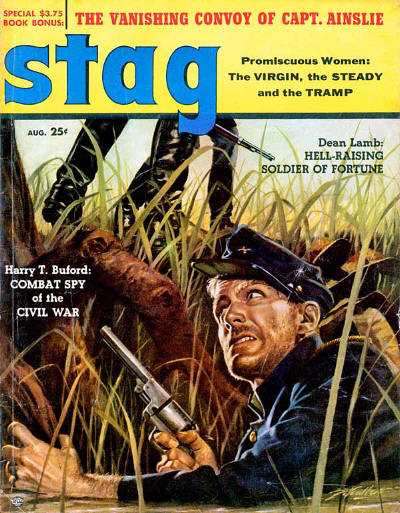 |
STAG for August, 1957, features a nice Civil War cover story. Purchased on eBay several years ago. |
Tuesday, May 28, 2013
Monday, May 27, 2013
MEMORIAL DAY MOVIES
I spent yesterday afternoon at the Paramount Theatre watching a terrific war movie double-feature. I had the pleasure of introducing SAHARA and SERGEANT YORK to an appreciative audience and I enjoyed both films immensely. SAHARA is a good movie, SERGEANT YORK is a great movie. I recommend both films to anyone who likes classic Hollywood movies, Humphrey Bogart, Gary Cooper and stories of heroes. Sound like just the thing for Memorial Day movie watching. Here are my notes for the films.
|
In the 1940s, as the United
States was caught up in the global conflict of World War II, moviegoers needed
reassurance that things would ultimately turn out okay. The U.S. and its’
allies (Great Britain and Russia), would surely prevail against the Axis forces
of Nazi Germany, fascist Italy and Imperial Japan. After all, the Allied Forces
(U.S., Great Britain and France) had won out in the previous world war against
Germany and they would most certainly do so again. Nonetheless, it didn’t hurt
to provide anxious film goers with reminders of the indomitable and undefeated
fighting spirit of the U.S. armed forces and Hollywood was quick and happy to
provide such material. There were numerous Hollywood war films produced during
the 1940s and almost every one of them stressed one thing: the U.S. would not
be defeated in foreign theaters of combat operations.
Here’s a bit of history to
consider. The conflict that we now refer to as World War I was never called
that while the fighting was taking place, nor was it referred to by that name
for the years immediately after the war was over. It was called simply The
Great War. After all, labeling the conflict World War I at the time would have
implied that surely another worldwide conflagration was due in the future and
no one was predicting that. Instead, The Great War or, The War to End All Wars,
only became known as World War I in hindsight when a second such global war
erupted in September, 1939 when Nazi Germany invaded Poland. When Howard Hawks’
flag-waving Great War epic Sergeant York
was released in July, 1941, the United States was still not fighting in World
War II. That would all change in a matter of months.
Sergeant York
is one of the greatest of war sagas because it is the true story of a simple
man who accomplishes extraordinary feats through quiet determination and faith.
Sergeant Alvin York was the most decorated American soldier of WWI and Gary
Cooper deservedly won acclaim for his portrayal of the famed WWI hero (York
himself insisted that Cooper take the role if his story was filmed) from rural
east Tennessee. At first hot-headed, with fast fists and no direction, Cooper
first changes his life with hard work meant to earn land for a farm that will
win him the hand of Joan Leslie. He then takes a devout turn after divine
intervention prevents him from murdering his rival for Leslie’s affections.
Reluctantly enlisted in WWI after denied conscientious objector status, Cooper
performs heroic feats motivated by his desire to stop a German machine-gun nest
from killing. Upon his return, Cooper is greeted with parades, Leslie’s love,
and a farm of his own presented by the people of Tennessee, a bounty that Cooper
ascribes to God’s grace.
Sergeant York
is an extremely compelling story, expertly directed by Howard Hawks. The themes
of inner strength from inspired purpose are first seen in York’s personal
struggles and then later in his actions on behalf of his comrades. Sergeant York received eleven Academy
Award nominations including: Best Picture, Best Director (Hawks), Best Actor
(Cooper, winner), Best Supporting Actor (Brennan), Best Supporting Actress
(Margaret Wycherly), Best Original Screenplay (Harry Chandlee, Abem Finkel,
John Huston and Howard Koch), Best Editing (William Holmes, winner), Best Art
Direction (John Hughes and Fred MacLean), Best Cinematography (Sol Polito) and
Best Music (Max Steiner). The film ranks number fifty-seven on the American Film
Institute’s list of one hundred most inspirational American films and Alvin
York is rated number thirty-five on the AFI list of top fifty heroes in
American film.
By the time Sahara was released in November 1943,
American troops had already had their first bitter taste of defeat at the hands
of German Field Marshall Erwin Rommel in fighting in North Africa. That
situation was quickly remedied by the leadership of General George Patton. Sahara is a premier WWII adventure film
set under the relentless, blistering Saharan sun in which Humphrey Bogart
commands a crippled tank retreating into the Libyan desert. As the crew
desperately searches for water, the tank squad picks up various stragglers from
defeated Allied units. The growing band fights off air attacks and then vies
with a Nazi battalion for a nearly dry well at a desert ghost town. There,
Bogart spurs the defeated, parched men into making a stand against the
overwhelming numbers of Germans.
At a time when most Hollywood
films were predictable and formulaic, Sahara
is never predictable thanks to the script by John Howard Lawson (who was later
blacklisted in the 1950s as a member of the alleged communist sympathizers The
Hollywood Ten) which fills the screen with action and memorable characters. Sahara received three Academy Award
nominations: Best Supporting Actor (J. Carrol Naish), Best Sound (John
Livadary) and Best Cinematography (Rudolph Mate).
MY MEN'S ADVENTURE MAGAZINES 16
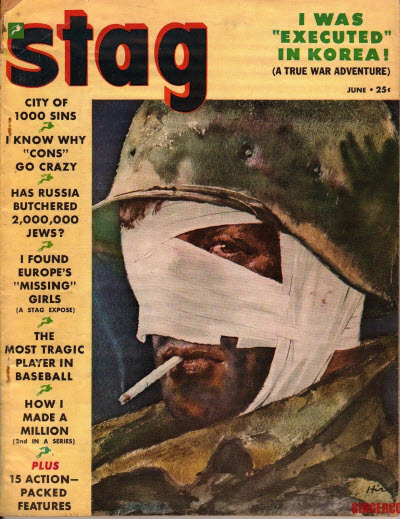 |
STAG for June, 1951, offers an appropriate image for this Memorial Day. Jack Kirby drew a similar image for the cover of FOXHOLE #1 in 1954.  My copy of STAG was purchased on eBay several years ago. |
Sunday, May 26, 2013
MY MEN'S ADVENTURE MAGAZINES 15
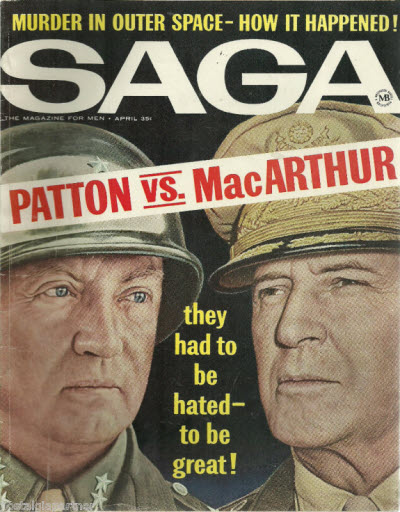 |
SAGA for April, 1963. This cover eschews the sensationalism usually found in the "sweats" for a straight military history approach. Purchased at a 2012 City Wide Garage Sale. |
Saturday, May 25, 2013
MY MEN'S ADVENTURE MAGAZINES 14
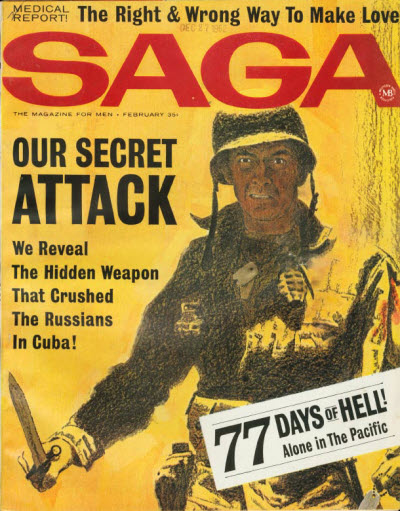 |
SAGA for February, 1963. Purchased at a 2012 City Wide Garage Sale. The banner headline "The Right and Wrong Way to Make Love" reminds me of this exchange from Woody Allen's MANHATTAN: Woman: "I finally had an orgasm the other day but my analyst told me it was the wrong kind." Woody Allen: "The wrong kind? I've been having orgasms for years and the worst one I ever had was right on the money." |
MY MEN'S ADVENTURE MAGAZINES 13
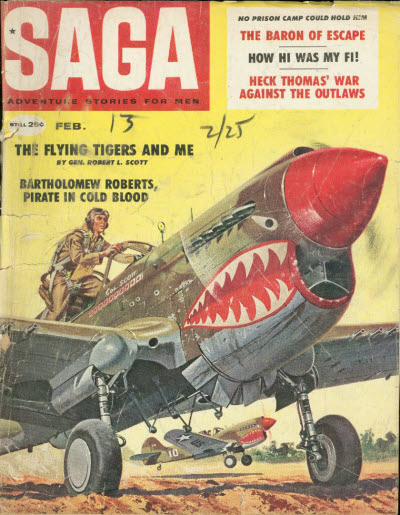 |
SAGA for February, 1959, sports a nifty Flying Tigers cover. Purchased at a 2012 City Wide Garage Sale. |
Friday, May 24, 2013
ANNIE HALL
 |
"Most of us need the eggs."
I spent the summer of 1977, between my junior and senior year in college, working as a house painter. The days were long and hot and filled with hard work, the drudgery and monotony broken only by noontime broadcasts of "Paul Harvey News and Comment." Nights and weekends were spent reading (mostly comic books and science fiction novels) and going to the movies. I saw a lot of movies that summer, many of them the same one.
That was the year that STAR WARS was released and before the summer was over, I had seen it six times. I did manage to see other films in between my visits to a galaxy far, far away, films such as Martin Scorsese's NEW YORK, NEW YORK, the Roger Moore James Bond epic THE SPY WHO LOVED ME (both at the long gone and dearly remembered Americana Theater) and several classic films on the University of Texas campus including Howard Hawks's AIR FORCE (1943) and CITIZEN KANE (1941) for the second (or was it the third? the fourth?) time. I saw another film at the Americana Theater that summer, a film that became one of my all time personal favorites.
I'd seen all of Woody Allen's films prior to ANNIE HALL, so I thought I knew what to expect going in: lots of laugh. The laughs I got, but there was more at work in this endearing film that was marketed as "a nervous romance". There was a bittersweet love story in addition to the hilarious one-liners. I fell in love with the film and have lost count of the number of times I've seen it over the years. Watching ANNIE HALL was practically an annual ritual with me for many years and I know that I sought refuge and solace in the film many times upon the occasions of failed romances of my own. ANNIE HALL became my cinematic comfort food whenever I needed to laugh or shed a tear (often both).
I watched ANNIE HALL again this afternoon. It's been several years since I saw it last and it still holds up. I don't think it's Woody Allen's funniest film. That honor goes to his debut effort, TAKE THE MONEY AND RUN, and I don't think it's his best film, which is, in my opinion MANHATTAN (a film that oddly enough, I didn't much care for the first time I saw it). But ANNIE HALL is by far Allen's most accessible, popular and well known work and it is a very, very good film.
I've seen it so many times that I know the dialogue by heart (thanks also to having read the screenplay several times) but familiarity hasn't diminished my respect and admiration for this gem. In ANNIE HALL, Woody Allen came of age as a filmmaker, using a variety of cinematic tricks to tell the story of his failed relationship with Annie Hall, who is wonderfully played by Diane Keaton. Was Keaton ever more delightful than in this film?
ANNIE HALL works as the memory of Alvy Singer (Allen), a paranoid and neurotic comedian, as he recounts his life, his romances and his relationship with Annie. As director, Allen fragments time and space to tell the story and he uses such devices as breaking the fourth wall (several times), an animated sequence, spilt screens in which characters separated by time and space converse with other, past scenes in which adult characters interact with their younger selves, a hilarious sub-titled sequence which reveals Alvy and Annie's real thoughts, a surprise appearance by Marshall McLuan (a brilliant and memorable scene) and on and on. And yet, with all of these tricks, the film is never confusing, never hard to follow or understand. We understand that this a story being told by Alvy and, like most remembrances, it's not related in a strictly linear sequence. The jumping around in time and place is the way our memories work and Allen captures this beautifully.
But beside the cinematic bravura on display here, there are some hilarious scenes and lines that I still quote to this day. Of all of the films I saw during that long ago summer of 1977, ANNIE HALL has stayed with me the longest. I loved it then and I enjoyed watching it again today.
I've seen many Woody Allen movies over the years but I have yet to see them all. I've missed many of his most recent works so I have some catching up to do. However, I did see Woody Allen on stage at the Paramount Theatre a couple of years ago when he performed with his jazz combo. To see one of my heroes live on the stage of my favorite theater was a once-in-a-lifetime event that I'll never forget.
|
MY MEN'S ADVENTURE MAGAZINES 12
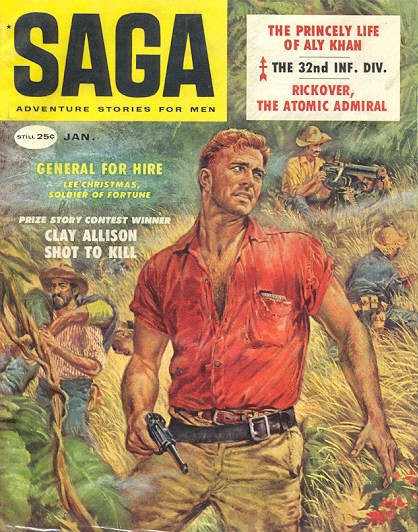 |
SAGA for January, 1959. Nice cover art on this magazine that advertises "adventure stories for men". Purchased at a 2012 City Wide Garage Sale. |
Thursday, May 23, 2013
MY MEN'S ADVENTURE MAGAZINES 11
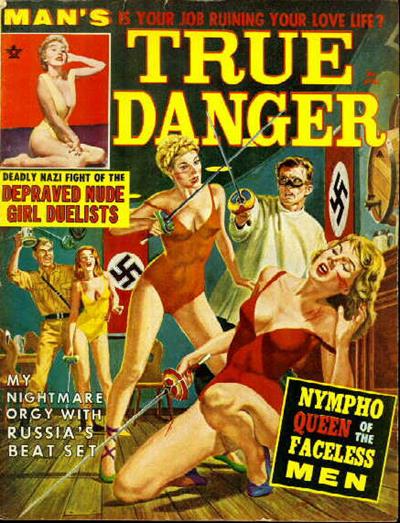 |
MEN'S TRUE DANGER from April, 1963. Possibly the best of all of my men's adventure mags. That cover art and copy says it all. This is what "men's sweat" mags are all about. Purchased at a 2012 City Wide Garage Sale. |
MY MEN'S ADVENTURE MAGAZINES 10
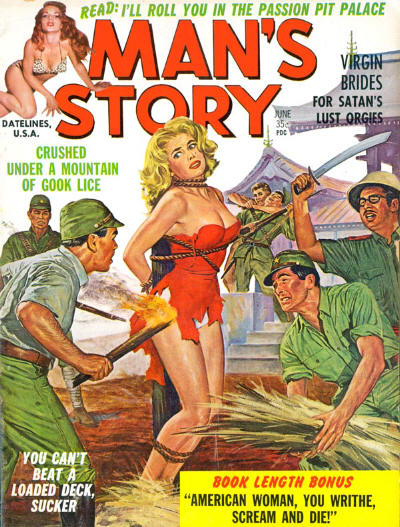 |
MAN'S STORY for June, 1961. Purchased at a 2012 City Wide Garage Sale. |
Wednesday, May 22, 2013
CASTING DOC: THE FINAL CHAPTER
 |
Paul Gleason (above), played the part of Major Thomas J. Roberts, aka "Long Tom" in the 1975 DOC SAVAGE movie. Long Tom was perhaps the weakest (in more ways than one) member of Doc's team and was certainly one of the least developed. An expert in electricity, Long Tom was consistently described as "puny", "weak", "scrawny", "pale", etc. In short, a rather unhealthy looking individual. It's hard to find actors that fit that description to play the part of Long Tom in our imaginary DOC SAVAGE movies, but I'm going to give it a go with some choices that are slightly off beat.  Elisha Cook, Jr. 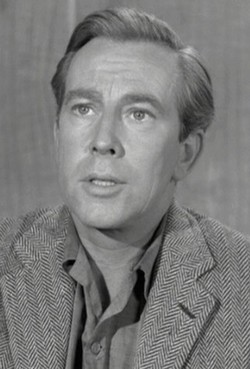 Whit Bissell 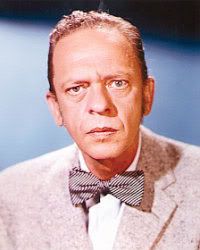 Don Knotts  John Fiedler 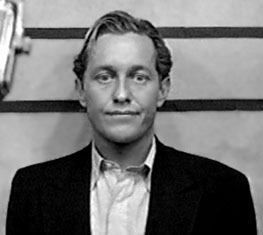 Strother Martin 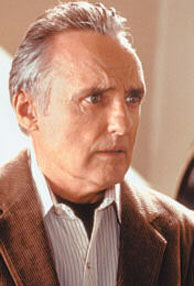 Dennis Hopper  Christopher Walken There you go, my choices for Long Tom and in other, recent blog posts, Doc, Monk, Ham, Renny, Pat and Johnny. What do you think? Agree? Disagree? Who would you cast in an imaginary DOC SAVAGE film? I'd love to hear comments and feedback from any and all Doc fans who are readers of this blog. I hope you had as much fun reading these as I did putting them together. |
SON OF CASTING DOC
 |
Actor Eldon Quick (pictured above) played the part of Johnny in the 1975 DOC SAVAGE movie. William Harper Littlejohn as the character was formally known, was the world's foremost expert on geology and archeology. He was bespectacled and had a penchant for using an extraordinarily large vocabulary. Here are some other actors that would have made good "Johnny's" in those un-produced, imaginary DOC SAVAGE movies I'm so fond of. 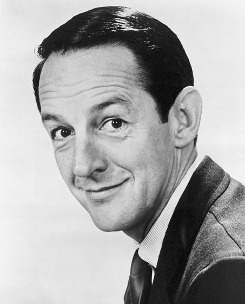 William Schallert  Herbert Anderson  Tony Randall  Wally Cox  Ray Walston 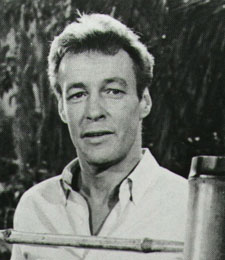 Russell Johnson |
MY MEN'S ADVENTURE MAGAZINES 9
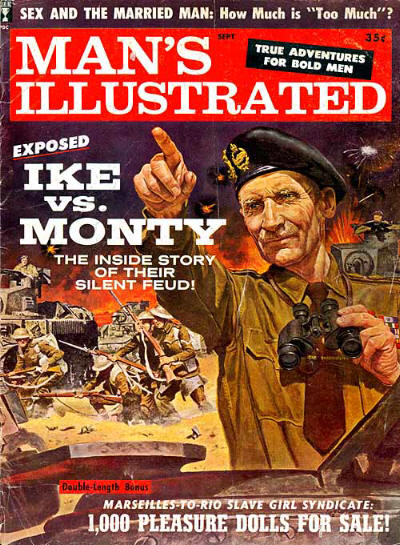 |
MAN'S ILLUSTRATED for September, 1960, cover features British General Bernard L. Montgomery illustrating a story about his feud with American General Dwight D. Eisenhower during World War II. This was sure to appeal to any veterans buying the mag, as well as WWII buffs in general, but when you're running a story entitled "1,000 Pleasure Dolls For Sale!", I'd think that's the article that deserves the cover illustration. That would be sure to drive sales on this magazine that proclaims it contains "true adventure for bold men". I guess they wouldn't sell it to timid men. Purchased at a 2012 City Wide Garage Sale. |
MY MEN'S ADVENTURE MAGAZINES 8
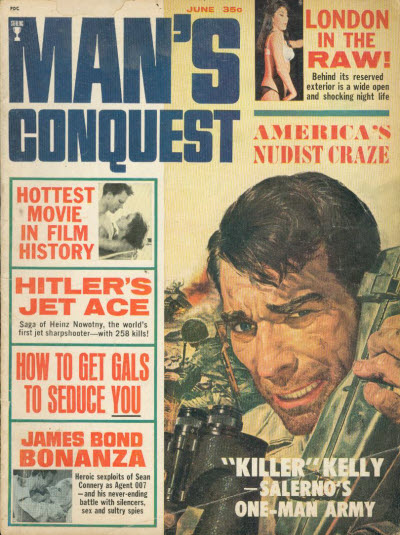 |
MAN'S CONQUEST from June, 1965 features a Richard Conte look-alike on the cover plus a James Bond pictorial! Purchased on eBay several years ago. |
Tuesday, May 21, 2013
BRIDE OF CASTING DOC
 |
To date, no actress has portrayed Doc's cousin Patricia Savage on screen (she's the one on the left in the image above, as if you couldn't tell).While Pat didn't appear in every Doc Savage adventure, she was in enough of them to make her a valuable, important and lovely part of the Doc mythos. It remains to be seen if Pat will appear in the Shane Black Doc Savage film and if so, which contemporary actress will play the part. But here are some choices for Pat in those imaginary, never-to-be-made Doc Savage films over the years. 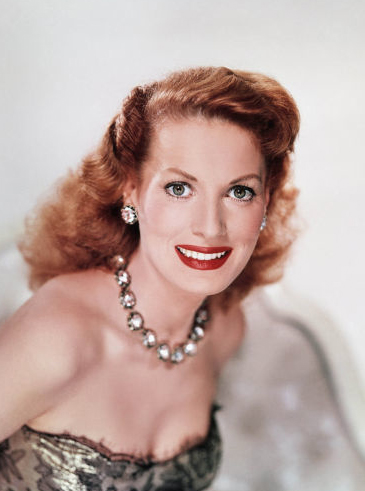 Maureen O'Hara  Rhonda Fleming  Gina Golan  Sharon Tate  Honor Blackman  Inger Stevens  Jill St. John  Raquel Welch  Ann-Margret Which one of these lovely ladies would you pick as Pat? |
Subscribe to:
Posts (Atom)
